9-3 Supporting Preschool Cognitive Development
A – STEM Subjects
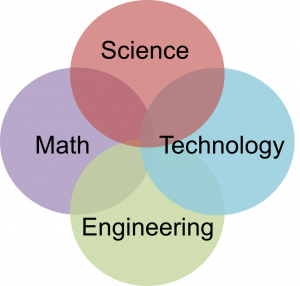
Again, STEM is an umbrella term, referring to a group of subjects linked together by a common approach and focus: They all require gathering and using evidence to create knowledge or solve problems.
STEM subjects are as relevant for preschool development as they are for infant and toddler development.
Just as we did in the last session with infants and toddlers, in this session we will cover how to support STEM learning for preschoolers. But first, let’s go over how STEM learning connects to the preschooler Head Start Early Learning Outcomes Framework domains.
STEM: Science
The Scientific Reasoning domain obviously relates to science learning.
But specifically, the subdomain Scientific Inquiry characterizes children’s development of observation skills and science talk—both important skills for science learning.
The ability to observe one’s environment helps you generate theories about how the world works and allows you to observe the outcomes of your own and other people’s explorations. Knowing the vocabulary of science learning and being able to use it helps children organize their investigations and place them in context.
The Reasoning and Problem-Solving subdomain characterizes children’s development of information-gathering, prediction, investigative, and analytical skills. All of these developmental skills are key components of science learning.
These are essentially the foundational building blocks of scientific studies: making predictions, gathering data, testing theories, and then analyzing and communicating those results.
STEM: Technology
While the connection between science learning and the domain Scientific Reasoning may seem apparent, the relevant domains for technology learning might not be as obvious.
The subdomain Scientific Inquiry is particularly relevant to this area of learning since it deals with children’s developing ability to sort, categorize, and observe with tools.
To sort and categorize, one must attend to the relevant attributes of a variety of objects. The ability to observe, find, and switch attention between important attributes of objects is a key component of learning new technologies.
Technology is also often used to extend the senses. The examples we used earlier, binoculars and microscopes, are forms of technology. Developing the skills to use these sense-extenders to aid in observation is important to the advancement of technology.
Video: Let’s Talk About STEM: Everyday Fun with Engineering (3:00)
This video shows children in different stages of development doing STEM activities. The video is about 3 minutes long
While viewing the video, consider the following questions:
- How are young children developing engineering skills?
- How are adults encouraging children’s engineering skills?
Watch Everyday Fun with Engineering from ZEROTOTHREE on Vimeo.

Video Debrief
How are young children developing engineering skills? (click to toggle expand or collapse)
Possible Answers
- Problem-solving skills.
- An understanding of patterns, sequencing, and cause and effect.
- Systems thinking, or understanding that when they act on one part of the system it influences another part.
How are adults encouraging children’s engineering skills? (click to toggle expand or collapse)
Possible Answers
- Describing what children are doing and what they are learning as they explore.
- Asking open-ended questions that help children focus on details that might encourage children to discover a solution.
- Showing a system in action, such as locking a door.
- Supporting them through the engineering process of exploring, creating, and improving.
STEM: Engineering
Engineering learning in the preschool years is primarily focused in the subdomains Measurement and Geometry and Spatial Sense.
Measurement is a critical engineering skill. Understanding how to compare different objects on the same scale, noting what scales are most informative, and knowing how to count quantities using various scales are all important foundational skills for engineering learning.
Also, understanding, recognizing, and creating shapes and spatial relationships between objects are important skills for engineering structures, whether a simple tower of blocks or a complicated skyscraper.
STEM: Math
Finally, preschoolers are developing many math skills in the Cognition domain, especially in Mathematics Development, one of the two preschool Cognition domains.
The Counting and Cardinality subdomain includes the development of relevant counting and number recognition and production skills, along with the critical development of understanding cardinality.
The subdomain Operations and Algebraic Thinking include the development of number combinations and comparisons like those used in arithmetic.
The Measurement subdomain includes the ability to use numbers to quantify objects and substances.
The Geometry and Spatial Sense subdomain includes the ability to understand geometric relationships.
B – Three Ways to Support Cognitive Development
At this point, we’ve covered a lot of cognitive skills that children are developing from 3 to 5 years of age and communicated about the rapid cognitive changes that are happening during this time.
Children are going from simple counting and maybe knowing the number 1 as a quantity at the age of 3 to being able to combine numbers through basic arithmetic and understanding the concept of cardinality (that the last number counted when counting a set of objects is the cardinality of objects in that set).
So, how do we, as adults, support children’s development of these cognitive skills?
As we did with infants and toddlers in Session 8, we will now cover three areas where you, as an adult, can support the cognitive development of children from 3 to 5 years of age:
- Designing learning environments (materials, spaces, tools)
- Providing social support (positive and responsive interactions and modeling)
- Planning learning experiences (interactive, theme-based activities)
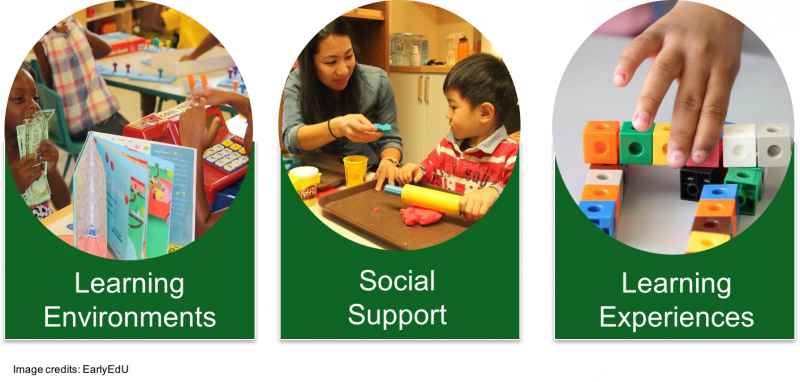
Learning Environment: Materials
First, remember the three characteristics to consider when choosing materials for children’s learning environments:
- Open-ended: Materials that can be used in multiple ways and allow for creativity, investigation, and problem solving
- Varied: A mix of materials and objects varying in size, shape, and texture
- Relevant: Related to children’s interests
The Focus of Inquiry
Children from 3 to 5 years of age are better able than younger children to focus on a particular topic of inquiry. It is important to support this ability to focus and pursue one line of inquiry.
The focus of the exploration might be considered the content.
As in selecting materials, children will be most engaged in the learning environment if the focus is based on their interests.
For example, children are naturally fascinated by living things. They may see a caterpillar in the yard and wonder how it is born, where it sleeps, or what it eats.
By finding out what children already know about caterpillars and butterflies, you can select materials to introduce new experiences and information. Children may collect caterpillars and observe, discuss, and document their observations
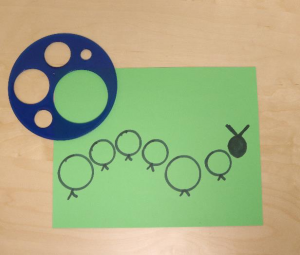
Here are some example caterpillar activities:
- Art: painting with different mediums, using cut potatoes to stamp the dots on the body
- Search and find: searching in the early learning outdoor environment or a local park for caterpillars
- Books: topics like the lifecycle of caterpillars
- Dress-up: wearing green or colored clothing and acting out the life cycle of the caterpillar
Tools for Investigation
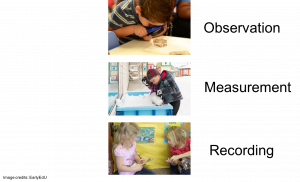
Scientists, even our youngest ones, also need access to the proper tools for their investigations, including tools for:
- Observation: magnifiers and hand lenses to help children observe details
- Measurement: measuring cups, balance scales, and measuring tape
- Recording: paper journals, pencils, markers, and cameras
When considering tools for investigations, remember to think about the ages and development of the young scientists with whom you are working. For example, individual paper journals are appropriate for older preschoolers, but recording for 3-year-olds will look much different.
Having the materials is not enough; they must be accessible to children. Not only should materials be where children can access them independently, but the tools should also be the proper size and type for young learners. An adult-sized pair of binoculars will be too heavy and not the right size for children’s eyes to line up properly to see.
When appropriate, adapt materials to ensure that children with special needs can participate as independently as possible. Some possible modifications include: placing the materials in an optimal position, stabilizing materials, providing adaptations to make tools easier to grasp, and making materials larger or brighter.
Materials for Play
There are many ways to support cognitive development through play. The materials you select don’t necessarily have to look like math materials.
For example, environments that support math development provide opportunities for children to use math as a language to describe the world around them.
Counting blocks and comparing quantities or sizes is a great way to practice math skills. Putting out baskets of pretend fruit and talking about the different shapes and sizes help children practice geometry skills. Using a scale to measure the weight of fruit supports the development of children’s measurement skills.
Remember that children are using math any time they compare amounts, such as more or less, or size, such as big or little; notice a sequence; play hopscotch; estimate a distance; or count.
Books
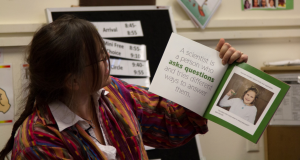
Besides experiencing STEM through nature, children can also experience it without leaving the early learning environment.
Books can be an engaging way to present STEM to children. Both fiction and non-fiction titles offer a way to introduce and discuss the complete range of STEM topics. You can use books to make connections to the real world and children’s experiences or to model approaches to problem-solving. Books can draw in students and act as a springboard for STEM activities.
For example, after reading the Three Little Pigs, provide children with straw, sticks, or blocks to construct a house to withstand the big bad wolf’s huffing and puffing.
Studies have shown that books encourage interest in science in the early years. They can provide accurate information in a way that’s interesting and easy for a child to understand.
Books also boost children’s science vocabulary. Knowing the names of things can prompt children to ask questions about their environment.
When using STEM books with children who are dual language learners, learn some of the key words and phrases in the children’s home languages. Use real objects, photographs, and illustrations to support them in acquiring the English words for key vocabulary and concepts.
C – Social Support
Again, social support is important for toddlers’ and infants’ cognitive development, and it is equally important for preschoolers.
Although older children are now developing more and more independence in their ability to learn and gather information, 3- to 5-year-olds still benefit from social support in their cognitive development. For example, adults can add new information or facts that children may not know and ask additional questions that children can explore.
Scaffolding and guided play are just as useful for older children as they are for younger children.
An important part of preschoolers’ cognitive development also includes the ability to convey findings or observations to those around them (Reasoning and Problem-Solving subdomain). This ability is primarily fostered through social interactions.
In addition, by actively observing individual children, we can assess their understanding of concepts.
Studying Social Support
Adults can help children who are learning through exploration. But we must be careful to guide without hampering children’s natural exploration. Too much direction from adults can sometimes narrow the range of children’s ideas.
Research shows that how an adult introduces a new task or object can impact preschoolers’ exploration and play.
In one study, children were shown a toy that had four unique features—a button that turned on a light, a mirror inside a tube, a tube that made a squeaky noise, and a button that played a song. Children watched an experimenter demonstrate just one of those features.
The researchers divided the children into three groups and gave each group a different introduction to the toy.
Three Approaches
For the first expert group, the experimenter brought out the toy and said, “Look at my toy! This is my toy. I’m going to show you how my toy works. Watch this!” Then the experimenter demonstrated that pressing one of the tubes makes it squeak.
In the second interrupted group, the experimenter said the same words as in the expert group. But this time, after squeaking the tube, they interrupted the demonstration and said, “I just realized I have to stop because I forgot to write down something over there. I have to go take care of it right now!” The experimenter then left the child to play with the toy.
In the third accidental discovery group, the experimenter acted as if the toy was new. The experimenter said, “Look at this toy. I just found this toy.” As they placed the toy on the table, they accidentally made the tube squeak. Then they said, “Huh, did you see that? Let me try to do that!” They purposely pressed the tube to make it squeak. The child then had a chance to play with the toy.
Researchers observed children’s responses in three areas:
- How long they played with the toy
- How many of the toy’s features they discovered
- How much they played with the squeaker
Impact on Children’s Exploration
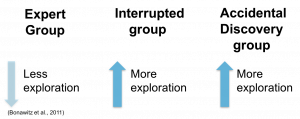
Children in the expert group spent less time playing with the toy overall and were less likely to discover the other features of the toy, but they spent more time playing with the squeaker than the other groups.
It seems that children who watched the experimenter introduce the toy as if they were the expert were less likely to explore it. They also spent more time playing with the feature the adult had highlighted. Children proceeded as if the feature the expert showed them was what they were supposed to play with too.
Even though the interrupted group heard the same introduction as the expert group, they were more likely to explore. This is because it appeared that the experimenter got interrupted. Children may have thought that there were other ways to play with the toy, but the experimenter had to leave before they could describe them all. Even that little bit of ambiguity made children more likely to explore.
Children in the accidental discovery group discovered more features than either the expert or the interrupted group. When the experimenter acted as if the toy was new to them as well, children were more likely to explore.
Children look to adults and trust their authority. Children are aware of teaching and assume that an educator has given them the information that is most important to know. Behaving like an expert signals children to follow our lead. Often, following an educator’s lead is the desired outcome, but in some circumstances, acting like an expert while children are exploring can limit their exploration and creativity.
STEM Co-Explorers
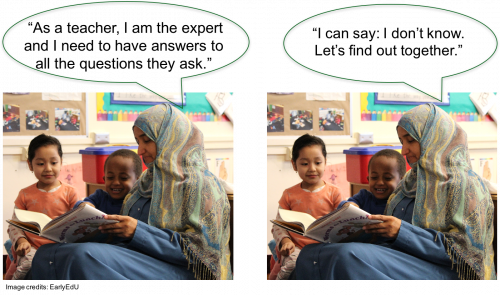
There are other reasons to consider how we present information to children.
In the traditional idea of a learning environment, the educator presents knowledge and children learn and retain it. This belief may cause some educators to be anxious about their abilities in STEM disciplines and ultimately cause them to avoid participating in these activities.
The good news is that by thinking about ourselves as co-explorers, we can reduce anxiety about teaching STEM concepts. When we change our perspectives about what teaching science looks like, we move from teaching specific content to children to listening to children’s questions and modeling a questioning mind. We no longer view ourselves as experts and recognize we do not have all the answers. Instead, we acknowledge and validate children’s thinking and look for answers to their questions together.
Here are some examples of goals we can have when working with children to shift our thinking. Instead of thinking, “As a teacher, I am the expert and I need to have answers to all the questions they ask,” we can approach the situation with the perspective of “I don’t know. Let’s find out together.”
Modeling A Questioning Mind
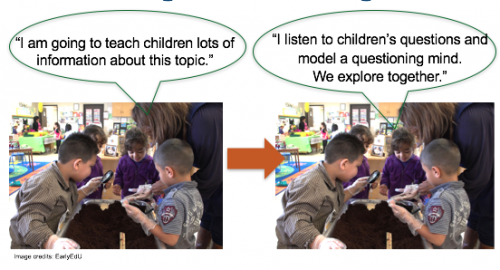
Here’s another example: Instead of approaching a lesson with the thought that “I am going to teach children lots of information about this topic,” we can shift to “I listen to children’s questions and model a questioning mind. We explore together.”

Reflection Point
Use these questions to consider the topic of when adults need to be experts when guiding children:
- In what instances do adults need to be the experts?
- What are some situations where adults don’t need to be the experts?
D – Social Interactions
Social interactions can support cognitive development in many ways. We will explore a few examples:
- Introducing the process of scientific inquiry explicitly
- Using scientific language
- Encouraging children to communicate and share their findings
Introducing Inquiry Skills
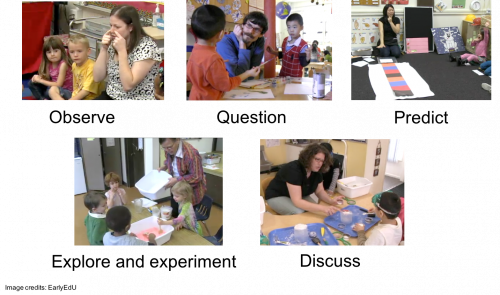
Adults can encourage children to learn about their world by introducing basic inquiry skills. Inquiry skills are a series of steps called the scientific method. The scientific method includes observing, forming questions, making predictions, designing and carrying out experiments, and discussing.
Adults can engage children in reflection through the process of asking questions, investigating, and constructing explanations. Asking open-ended questions also models this process for children so that ultimately, they will develop questions about their observations.
Encourage children to think about their observations and their questions. From what they know and want to know, they can make predictions and say what they think will happen. Encourage children to experiment and test their predictions.
During and following their explorations and experiments, provide opportunities for children to discuss the results of their experiments. Communicating their thoughts and ideas helps children develop their thinking.
Using Scientific Language
How else can adults support children as they observe, question, explore, and reflect? One of the ways we can do this is with language.
The way adults speak to children can encourage reflection and problem-solving. By modeling and providing children with meaningful opportunities to use scientific language, we are not only enhancing children’s science learning, but we are also teaching advanced vocabulary in a meaningful context.
Inviting Communication
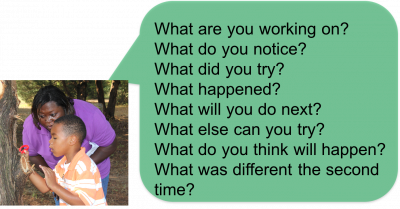
Invite children to communicate as they engage in the process of scientific inquiry by asking open-ended questions and most importantly, accepting their answers without judgment. This also allows an adult to learn about the child’s thinking, so they can help extend their learning.
Here are some questions to encourage problem-solving with young children:
- What are you working on?
- What do you notice?
- What did you try?
- What happened?
- What will you do next?
- What else could you try?
- What do you think will happen?
- What was different the second time?
This will also model asking questions for children developing the ability to gather information on their own.
Older children ask questions to learn about the world. In one study, children between the ages of 2 and 5 were found to ask an average of 76 questions per hour.
Their questions included requests for many different types of information. Fact-based questions were the most frequent, but requests for explanations increased with age. Between the ages of 2 and 2-and-a-half, only 4 percent of children’s questions were requests for explanations. But at age 5, an average of 30 percent of children’s questions were requests for explanations.
About age 3, children showed a considerable increase in the proportion of requests for explanations. This suggests that about this time, children use inquiry as another tool to help them figure out how things work.

Reflection Point
Use these questions to review the material from this section:
- What are three ways to support preschool cognitive development through social interactions?
- Based on the research findings, when an adult presents an object as an expert:
- How can this hinder learning in preschoolers?
- How can this help their learning?
E – Interactive Learning Experiences
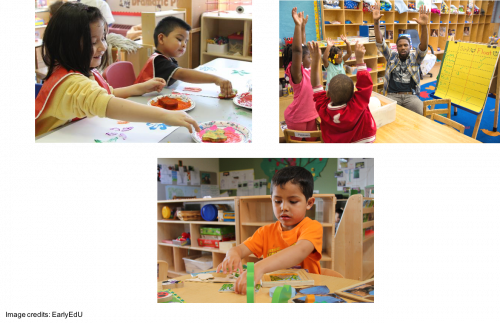
With greater motor ability and independence as children get older, the design of engaging learning experiences also changes.
Adults can find many ways to engage preschoolers in interactive learning experiences that support their cognitive development.
- Book reading
- Measurement activities
- Object-exploration activities (e.g., sink or float)
- Categorization tasks
- Games that practice executive function skills (e.g., Simon Says)
- Problem-solving tasks
We’ll now present some examples of learning activities and how they relate to cognitive development.
Using Books
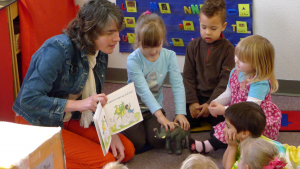
Many researchers agree that using picture books, if they are carefully chosen, can be an effective approach to teaching science concepts to young children.
Almost any book can connect to STEM topics through discussion and questions like the ones we considered earlier, such as “What do you notice about the two trees?”
When selecting STEM-related books for young children, you can:
- Start with: Is it fun to read? Do you like it? Do you respond to the language and illustrations? Is it captivating—a good story? Chances are that if you enjoy reading the book, the children you read it with will enjoy it too.
- Examine whether the book has a theme and if the theme is one you want to share.
- Look for books that show gender and racial diversity. Help children avoid making inferences about who may find STEM relevant by presenting books with characters of different genders, races, and cultures engaged in STEM-related activities. STEM is for everyone, not just a certain type of person.

Reflection Point
Use these questions to discuss STEM books:
- Do you have a favorite children’s book that is STEM-related?
- What is it?
- What topics do you like to relate to it?
F – Measurement Activities
Making Comparisons
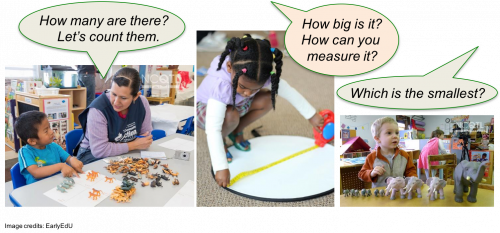
Encourage children to make quantity or size comparisons through measurement activities.
An adult may ask, “How big is it?” A child can estimate, measure, and describe.
An adult may ask, “How could you measure it?” A child can analyze the possibilities.
Check in with children about their measurement theories by asking them why something is bigger or smaller or has more or less. Sometimes they will surprise you with their explanations.
Sorting
Sorting games can engage children as well. Try to set them up so that items can be categorized based on more than one feature, such as color, shape, or size.
 Interactive: Shape Sorting
Interactive: Shape Sorting
This is an interactive! You’ll drag and drop the shapes onto different areas of the screen to make as many different sorting groups as you can.
 Activity Debrief
Activity Debrief
What are some common ways to sort? (click here to reveal)
Why it matters
Possible Answer
Did you group the shapes by color? Did you notice that there was more than one way to sort the objects?
Sorting and categorizing games like this one, or ones in which objects must be sorted first by one feature, such as color, and then another, such as shape, help children learn to recognize and switch between two sets of rules.
You can even include items that have differences in invisible properties, such as weight (heavy versus light) or sound (rattles versus bells).
Vroom Tip
Check out this Vroom tip to get more ideas about how to talk about categories with young children.
Does this tip make sense in the context of an early learning environment? And if not, how might you adapt the activity to better fit that environment?
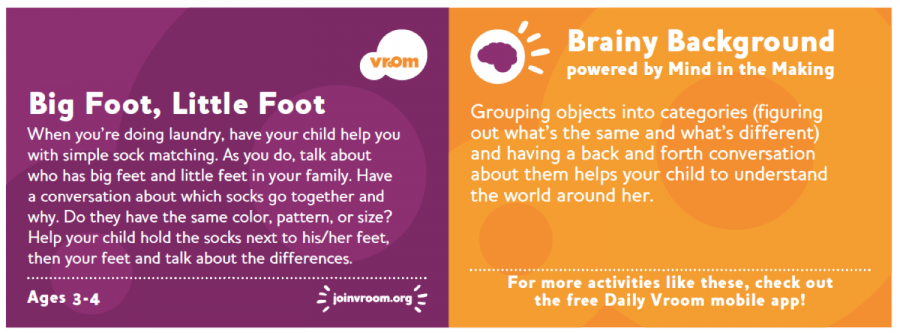
View text-only alternative of this Vroom card
Big Foot, Little Foot
When you’re doing laundry, have your child help you with simple sock matching. As you do, talk about who has big feet and little feet in your family. Have a conversation about which socks go together and why. Do they have the same color, pattern, or size? Help your child hold the socks next to his/her feet, then your feet and talk about the differences.
Ages 3-4
Brainy Background powered by Mind in the Making
Grouping objects into categories (figuring out what’s the same and what’s different) and having a back and forth conversation about them helps your child to understand the world around her.
Hands-On Learning Experiences
STEM is all around us, ready to be discovered by willing young explorers.
Remember that children are active learners. Try to provide them with hands-on experiences for learning.
In summary, when making efforts to support children’s cognitive development remember to:
- Select materials and activities that engage the senses: textures, smells, tastes, sounds, and sights. Set up a taste test, and have children compare foods. Ask which is crunchier, sweeter, or smoother. Combine science and art. Have children paint different surfaces with the same color then compare their appearance.
- Design activities that ask children to sequence, identify the steps in a process, or put items in order by size or weight. These are all precursors to understanding computer languages. Regularly include counting and measuring in activities. Tools for measuring and weighing help with number familiarity.
- Play games that use executive function. These can be simple clapping patterns and rhymes, sorting tasks, or motion games like Simon Says.
- Speak STEM by including problem-solving and math-rich language in all types of activities. Listen to children’s observations and provide scaffolds when appropriate.
- Explore the outdoors and nature. These are settings that encourage creative and active exploration and problem-solving.
- Read fiction and non-fiction books with STEM-related content. Literature provides a great springboard for discussion and activities.
- Schedule open-ended time. Children need time to become fully engaged in exploration and investigations.
 References
References
Bonawitz, E., Shafto, P., Gweon, H., Goodman, N., Spelke, E., & Schulz, L. (2011). The double-edged sword of pedagogy: Instruction limits spontaneous exploration and discovery. Cognition, 120(3), 322-330.
Gopnik, A. (2011, March 16). New research shows that teaching preschoolers more and more, at ever-younger ages, may backfire. Slate. [Online Article]
Master, A. (2016, September 27). Group work gets kids more engaged in STEM. The Conversation. [Online Article]
Salmon, A K. (2010). Tools to enhance young children’s thinking. Young Children 65(5), 26-31.
Vroom. (n.d). Vroom tips. [PDF]
Zero To Three. (n.d.). Let’s talk about STEM: Everyday fun with engineering. [Video]
EarlyEdU Alliance (Publisher). (2018). 9-3 Supporting preschool cognitive development. In Child Development: Brain Building Course Book. University of Washington. [UW Pressbooks]

